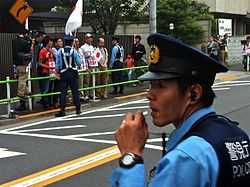Anti-Chinese sentiment in Japan
Anti-Chinese sentiment in Japan has been present since the Tokugawa period and continues today as the Japanese warily watch "China's peaceful rise."
Tokugawa period
From 1600 to 1868, during the Tokugawa period, Japan transformed from a country divided by civil war to a unified, stable, and mature state.[1] This period saw an attempt to remove foreign, including Chinese, influence on Japanese culture.
During this time, Japan remained isolated from the world, so its culture developed with very little foreign influence. One of the major cultural movements of the Tokugawa period was the institution of a branch of scholarship called kokugaku, literally "National Studies" and commonly translated as "Japanese Studies". Practitioners of the movement, or Kokugakushu, attempted to distinguish between what was genuine Japanese culture and what was foreign culture,[2] and to restore Japanese culture to what it was before the influence of foreigners—especially the Chinese.[3] Their work had a large focus on Shinto,[2] Japan's indigenous religion.[4] Early Tokugawa Confucians tried to link Shinto with China by pinpointing its Chinese origins. The Hirata school of the kokugaku movement responded by initiating a project to "Japanize" the I Ching, a book that was a major influence on Shinto, by claiming it was of Japanese origin. The project was completed with Aizawa Seishisai emptying the I Ching of its Chinese content.[5] The rise in national self-respect during this time resulted in Japan viewing itself as the center of a "civilized world surrounded by barbarians."[6]
Meiji Restoration
From 1866 to 1869, during Japan's Meiji Restoration, the country was able to catch up with the progress of western nations.[7] Meanwhile, China was sinking into a state of deep dysfunction. Although Yukichi Fukuzawa refused to recognise China as a bad friend in "Datsu-A Ron" (translated to "Argument for Leaving Asia"), this was not the prevailing attitude and the discriminating consciousness to China remained.
These Sinophobic sentiments fueled the Imperial soldiers' atrocities committed against the Chinese during World War II, culminating in the Nanking Massacre. The Second Sino-Japanese War claimed the lives of more than 20 million Chinese, mostly civilian. The property loss suffered by the Chinese was valued at US$383 billion according to the currency exchange rate in July 1937, roughly 50 times the GDP of Japan at that time (US$7.7 billion).[8]
Post World War II

Openly Sinophobic sentiments were stifled following the end of the World War II and became taboo in the mainstream media, even though Japan and the People's Republic of China took opposite sides in the Cold War. Except in a handful of cases, such as the Japanese name for "South China Sea" and an alternative term for ramen, use of the word Shina (China) all but disappeared.
There was little contact between Japan and the People's Republic of China in the ensuing decades. There was little discussion of China until the relationship between the countries was normalised in 1972, when there was a surge of interest in Japan about its neighbour. China renounced reparations for the Second World War, partly to avoid appearing less generous than Taiwan—which had earlier done the same—and to strengthen its position against the Soviet Union. The response was considerable gratitude and goodwill in Japan. Sinophobia was confined to the context of fear of communism. Public animosity toward the People's Republic of China was minimal compared to the public animosity held against the Soviet Union, and a friendly mood prevailed.[10] Improvements were also seen in social attitudes toward ethnic Chinese residents of Japan, along with other minorities such as Zainichi Koreans and Ainu people.
However, since 2000, Japan has seen a gradual resurgence of anti-Chinese sentiments. The xenophobic sentiments are coupled with the effects of an increasingly tense political relationship between Japan and the People's Republic of China. Many Japanese believe that China is using the issue of the countries' checkered history, such as the Japanese history textbook controversies and official visits to the Yasukuni Shrine, both as a diplomatic card and to make Japan a scapegoat in domestic politics.[11] The Anti-Japanese Riots in the spring of 2005 caused more fear of China within the Japanese public. Anti-Chinese sentiments in Japan have been on a sharp rise since 2002. According to Pew Global Attitude Project (2008), unfavorable view of China was 84%, unfavorable view of Chinese people was 73%.[12]
See also
- Anti-Japanese sentiment in China
- Anti-Chinese sentiment in the United States
- Sinophobia
- 2005 anti-Japanese demonstrations
- Nativism (politics)
- Datsu-A Ron
References
- ↑ Tokugawa Period. BookRags. Retrieved on 2008-08-24.
- ↑ 2.0 2.1 Tokugawa Enlightenment
- ↑ First 1500 characters of Shintoism. 123HelpMe.com. Retrieved on 2008-08-24.
- ↑ Shinto. Japan-guide.com. Retrieved on 2008-08-24.
- ↑ Ng, Wai-ming. The I Ching in the Shinto Thought of Tokugawa Japan. University of Hawaii Press (1998). Retrieved on 2008-08-24.
- ↑ Kanji Nishio II. Japan's Identity: Is Asia One? Is Japan Part of the East? Japan Forum on International Relations. Retrieved on 2008-08-24.
- ↑ Japan needs an Obama. The Jakarta Post. Retrieved on 2008-09-03.
- ↑ Nuclear Power: The End of the War Against Japan
- ↑ http://pewglobal.org/database/?indicator=24&response=Unfavorable>
- ↑
- ↑ Matthew Forney, "Why China Loves to Hate Japan". Time Magazine, December 10, 2005. http://www.time.com/time/world/article/0,8599,1139759,00.html, accessed 1 June 2008
- ↑ 24-Nation Pew Global Attitudes Survey(2008) 35p, Pew Research
